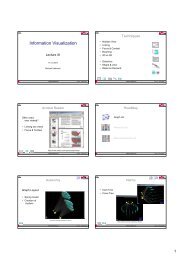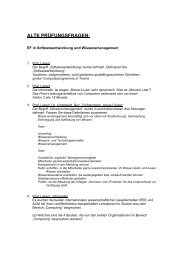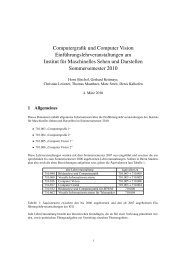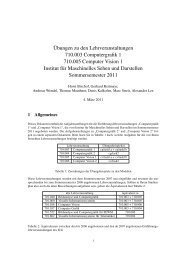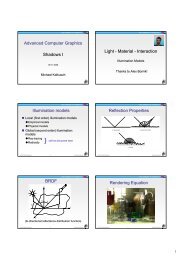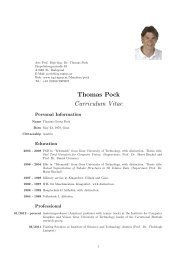Lehrveranstaltungsinhalt aus - Institute for Computer Graphics and ...
Lehrveranstaltungsinhalt aus - Institute for Computer Graphics and ...
Lehrveranstaltungsinhalt aus - Institute for Computer Graphics and ...
Create successful ePaper yourself
Turn your PDF publications into a flip-book with our unique Google optimized e-Paper software.
0.14. THE ROLE OF THE INTERNET 19<br />
the strips need to be merged <strong>and</strong> how any discrepancies between those strips, particularly in their<br />
overlaps, need to be removed by some computational measure. In addition, one needs to know<br />
points on the ground with their true coordinates in order to remove any uncertainties that may exist<br />
from the airplane observations. So finally we have a matched, merged, cleaned-up data set <strong>and</strong> we<br />
now can do the same thing that we did with the DEM from aerial photography, namely we merge<br />
the elevation data obtained from the laser scanner with potentially simultaneously collected video<br />
imagery, also taken from that same airplane: We obtain a laser scan <strong>and</strong> phototexture product.<br />
0.14 The Role of the Internet<br />
It is of increasing interest to look at a model of a city from remote locations. An example is the<br />
so-called “armchair tourism”, vacation planning <strong>and</strong> such. Slide 0.152 is an example of work done<br />
<strong>for</strong> a regional Styrian tourism group. They contracted to have a mountain-biking trail advertised<br />
on the Internet using a VRML model of the terrain. Shown is in Slide 0.153 a map near Bad<br />
Mitterndorf in Styria <strong>and</strong> a vertical view of a mountain-biking trail. Slide 0.154 is a perspective<br />
view of that mountain-bike trail super-imposed onto a digital elevation model that is augmented<br />
by photographic texture obtained from a satellite. This is actually available today via the Internet.<br />
The challenge is to compress the data without significant loss of in<strong>for</strong>mation <strong>and</strong> to offer that<br />
in<strong>for</strong>mation via the Internet at attractive real-time rates. Again Diploma <strong>and</strong> Doctoral thesis<br />
topics could address the Internet <strong>and</strong> how it can help to transport more in<strong>for</strong>mation faster <strong>and</strong> in<br />
more detail <strong>and</strong> of course in all three dimensions.<br />
Another example of the same idea is an advertisement <strong>for</strong> the Grazer Congress on the Internet.<br />
The Grazer Congress’s inside was to be viewable to far away potential organizers of conferences.<br />
They obtain a VRML view of the various inside spaces. Bec<strong>aus</strong>e of the need to compress those<br />
spaces, the data are geometrically very simple, but they carry the actual photographic texture<br />
that is available through photographs taken at the inside of the Grazer Congress.<br />
The Internet is a source of a great variety of image in<strong>for</strong>mation, an interesting variation of the city<br />
models relates to the so-called “orthophoto”, namely photographs taken from the air or from space<br />
that are geometrically corrected to take on the geometry of a map. The example of Slide 0.158<br />
shows the downtown of Washington D.C. with the U.S. Capitol (where the parliament resides).<br />
This particular web site is called “City Scenes”.<br />
0.15 Two Systems <strong>for</strong> Smart Imaging<br />
We already talked about imaging by regular cameras, by radar or non-imaging sensing <strong>and</strong> by<br />
laser. Let’s go a step further: specific smart sensing developed <strong>for</strong> city mapping. As part of a<br />
doctoral thesis in Graz a system was developed to be carried on the roof of a car with a number<br />
of cameras that allow one to reconstruct the facades of buildings in the city. Images are produced<br />
by driving with this system along those buildings. At the core of the system is a so-called linear<br />
detector array consisting of 6,000 CCD elements in color. These elements are combined with two<br />
or three optical systems, so that 3,000 elements are exposed through one lens <strong>and</strong> another 3,000<br />
elements through another lens. By properly arranging the lenses <strong>and</strong> the CCDs one obtains a<br />
system, whereby one lens collects a straight line of the facade looking <strong>for</strong>ward <strong>and</strong> the other lens<br />
collects a straight line either looking backwards or looking perpendicular at the building.<br />
In Slide 0.163 we see the car with the camera-rig driving by a few buildings in Graz- Kopernikusgasse.<br />
Slide 0.164 shows two images with various details from those images in Slide 0.165, in<br />
particular images collected of the Krones-Hauptschule. Simultaneously with the linear detector<br />
array collecting images line by line as the car moves <strong>for</strong>ward (this is also called “push broom<br />
imaging”), one can take images with a square array camera. So we have the lower resolution



